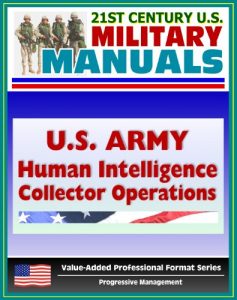This manual. converted for accurate flowing-text ebook format reproduction, provides doctrinal guidance, techniques, and procedures governing the employment of human intelligence (HUMINT) collection and analytical assets in support of the commander's intelligence needs. It outlines HUMINT operations, the HUMINT collector's role within the intelligence operating system, and the roles and responsibilities of the HUMINT collectors and the roles of those providing the command, control, and technical support of HUMINT collection operations.
Topics covered include: interrogation procedures; the handling of enemy combatants, POWs, and detainees; the role of military police; DOCEX (document exploitation); emotional approaches; question types; deceit detection; expert participation; map-tracking techniques; reporting architecture; use of interpreter; pattern analysis; HARMONY; the Geneva conventions, and much more.
This manual applies to the Active Army, the Army National Guard/Army National Guard of the United States, and the United States Army Reserve unless otherwise stated. This manual also applies to DOD civilian employees and contractors with responsibility to engage in HUMINT collection activities. It is also intended for commanders and staffs of joint and combined commands, and Service Component Commands (SCC). Although this is Army doctrine, adaptations will have to be made by other Military Departments, based on each of their organizations and specific doctrine.
Material in this manual applies to the full range of military operations. Principles outlined also are valid under conditions involving use of electronic warfare (EW) or nuclear, biological, or chemical (NBC) weapons.
This manual is intended for use by military, civilian, and civilian contractor HUMINT collectors, as well as commanders, staff officers, and military intelligence (MI) personnel charged with the responsibility of the HUMINT collection effort.
HUMINT operations vary depending on the source of the information. It is essential that all HUMINT collectors understand that, whereas operations and sources may differ, the handling and treatment of sources must be accomplished in accordance with applicable law and policy.
Topics covered include: interrogation procedures; the handling of enemy combatants, POWs, and detainees; the role of military police; DOCEX (document exploitation); emotional approaches; question types; deceit detection; expert participation; map-tracking techniques; reporting architecture; use of interpreter; pattern analysis; HARMONY; the Geneva conventions, and much more.
This manual applies to the Active Army, the Army National Guard/Army National Guard of the United States, and the United States Army Reserve unless otherwise stated. This manual also applies to DOD civilian employees and contractors with responsibility to engage in HUMINT collection activities. It is also intended for commanders and staffs of joint and combined commands, and Service Component Commands (SCC). Although this is Army doctrine, adaptations will have to be made by other Military Departments, based on each of their organizations and specific doctrine.
Material in this manual applies to the full range of military operations. Principles outlined also are valid under conditions involving use of electronic warfare (EW) or nuclear, biological, or chemical (NBC) weapons.
This manual is intended for use by military, civilian, and civilian contractor HUMINT collectors, as well as commanders, staff officers, and military intelligence (MI) personnel charged with the responsibility of the HUMINT collection effort.
HUMINT operations vary depending on the source of the information. It is essential that all HUMINT collectors understand that, whereas operations and sources may differ, the handling and treatment of sources must be accomplished in accordance with applicable law and policy.






